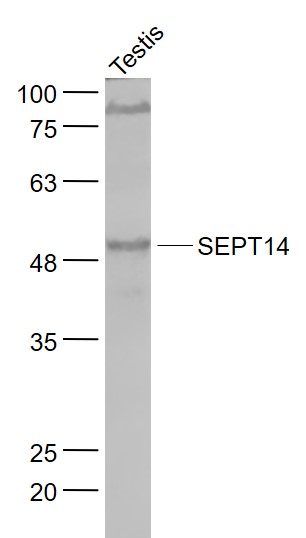
Rabbit Anti-SEPT14 antibody
SEPT14; SEPT 14; SEP14_HUMAN; Septin-14; Septin 14; Septin14; FLJ44060.
View History [Clear]
Details
Product Name SEPT14 Chinese Name Cell differentiation蛋白SEPT14抗体 Alias SEPT14; SEPT 14; SEP14_HUMAN; Septin-14; Septin 14; Septin14; FLJ44060. Research Area Cell biology Cyclin Cell differentiation Cytoskeleton Immunogen Species Rabbit Clonality Polyclonal React Species Mouse, Rat, (predicted: Human, ) Applications WB=1:500-2000 ELISA=1:5000-10000
not yet tested in other applications.
optimal dilutions/concentrations should be determined by the end user.Theoretical molecular weight 50kDa Cellular localization cytoplasmic Form Liquid Concentration 1mg/ml immunogen KLH conjugated synthetic peptide derived from human SEPT14: 351-432/432 Lsotype IgG Purification affinity purified by Protein A Buffer Solution 0.01M TBS(pH7.4) with 1% BSA, 0.03% Proclin300 and 50% Glycerol. Storage Shipped at 4℃. Store at -20 °C for one year. Avoid repeated freeze/thaw cycles. Attention This product as supplied is intended for research use only, not for use in human, therapeutic or diagnostic applications. PubMed PubMed Product Detail Septin 14, also known as SEPT14, is a 432 amino acid protein that belongs to the septin family. The highly conserved septin family of GTP-binding cytoskeletal proteins is implicated in membrane transport, apoptosis, cell polarity, cell cycle regulation, cytokinesis and other cellular functions. Septins polymerize into heterooligomeric protein complexes that form filaments, and can associate with cellular membranes, actin filaments and microtubules. Septin 14 has a GTPase domain followed by a C-terminal coiled-coil domain characteristic of group II septins. Septin 14 interacted with all septins except those that are members of its phylogenetic cluster, including itself. Septin 14 shares highest identity (67%) with Septin 10. Expressed in testis and more weakly in fetal liver, tonsil and thymus, the Septin 14 protein is not detected in testicular cancer or other normal or cancer cell lines. The Septin 14 gene is conserved in chimpanzee, dog, cow, mouse and rat, and maps to human chromosome 7p11.2.
Function:
SEPT14 is a filament-forming cytoskeletal GTPase. It may play a role in cytokinesis.
Subunit:
Septins polymerize into heterooligomeric proteincomplexes that form filaments, and can associate with cellularmembranes, actin filaments and microtubules. GTPase activity isrequired for filament formation (By similarity). Interacts withSEPT9.
Subcellular Location:
Cytoplasm.
Tissue Specificity:
Testis-specific.
Similarity:
Belongs to the septin family.
SWISS:
Q6ZU15
Gene ID:
346288
Database links:Entrez Gene: 346288 Human
Omim: 612140 Human
SwissProt: Q6ZU15 Human
Unigene: 453629 Human
SEPTIN(SEPT)家族是Cytoskeleton蛋白的一种,具有GTPase的活性。经研究发現,SEPT参与细胞的分裂、The cell membrane的运输以及构成Cytoskeleton。Product Picture
References (0)
No References
Bought notes(bought amounts latest0)
No one bought this product
User Comment(Total0User Comment Num)
- No comment



 +86 571 56623320
+86 571 56623320
 +86 18668110335
+86 18668110335

